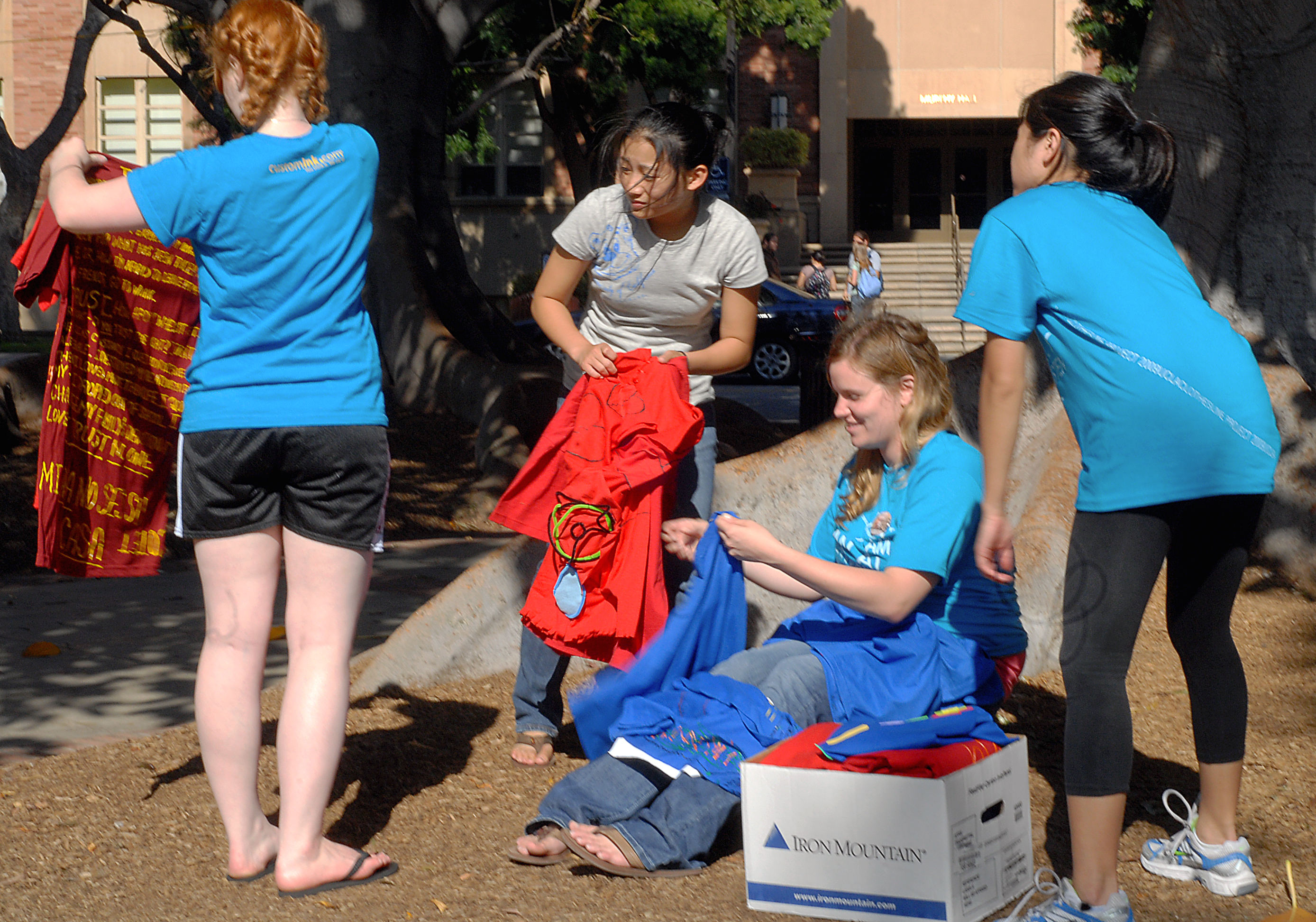Project offers victims a line of communication, support

In Dickson Court, organizers of the Clothesline Project at UCLA examine shirts made by survivors of sexual violence.
By Audrey Kuo
May 19, 2009 10:33 p.m.
Hundreds of shirts hanging between the trees of Dickson Court flutter gently in a warm spring breeze.
The bright colors of the cotton T-shirts and the handwritten letters in markers and paint belie the painful messages displayed on each.
Puffy felt clouds sewn onto the bottom of a blue shirt are filled with red words: “You were like an uncle until you drugged and raped me @ 16.”
A blue shirt with a red shirt tucked in it declares in bold capitals, “Mom, I don’t blame you, but I fault you for being too busy and afraid to notice.”
Another blue shirt near it doesn’t have sentences, just words: “angry,” “sad,” “Yvonne,” “age 7.”
The 20 or so clotheslines include shirts on display for the 12th year now, part of the UCLA Clothesline Project, an annual event that strives to break the silence about sexual violence.
The project symbolizes the airing of dirty laundry, as well as provides survivors with a way to share their stories.
“The juxtaposition of the beauty of the display and the pain of what’s going on ““ that’s what makes it so powerful,” said Jenna Rodman, a first-year transfer student in women’s studies volunteering at the event.
Rodman said passersby tend to read a few shirts, then look up and notice just how many shirts are hanging on the clotheslines.
The magnitude of the project represents the sheer number of cases of sexual violence. According to the U.S. Department of Justice, someone in the United States is sexually assaulted every 2.5 minutes.
The World Health Organization determined that one-third of girls worldwide are forced into their first sexual experience.
Lindsay Tucker, a first-year nursing student, stopped in her tracks when she entered Dickson Court.
“Do you know what these are?” she asked me.
I told her the shirts were made by survivors of sexual violence, and she looked shocked and said, “Oh my goodness. That’s scary.”
Like so many other visitors, Tucker read the shirt closest to her, then started slowly walking through the clotheslines.
She reached out to the blue shirt that bore the words, “Mom, I don’t blame you,” moving a sleeve so she could read the entire message.
Later, she said the display was shocking, especially a shirt that described a rape incident at UCLA.
“It’s so sad,” she said. “I don’t like that it happened. But it’s good for people to see it, because we don’t like to talk about it.”
And according to Rodman, that’s just what the Clothesline Project seeks to do ““ start discussions about sexual violence to “interrupt the status quo” of silence and repeated abuse.
“We want sexual violence not to be OK, not to be accepted,” she said.
The organization is also dedicated to supporting victims. “We want people to know they’re not alone,” Rodman added.
On Thursday at 7 p.m., Clothesline Project will co-sponsor Take Back the Night in De Neve Quad, a rally to empower students, survivors and allies.
Before she began attending UCLA, Rodman visited campus last year and saw the Clothesline Project.
She came back two days later for Take Back the Night and participated in the event’s open mic.
As a victim herself, Rodman said she was hesitant at first about speaking, but the dynamic of the audience made her feel comfortable.
“It’s one thing to say something in private, another thing to say it in front of people who are supporting you,” she recalled.
Rodman said she had felt alone as a victim, and her own experiences motivated her to serve others. She decided to transfer to UCLA so she could join the Clothesline Project.
The organization strives to create discussions, encouraging victims to seek support and allies to put an end to “victim blaming” and myths about sexual violence.
The color-coded shirts are a reminder that sexual violence can have multiple forms: Red and pink shirts represent survivors of rape or assault, blue and green shirts represent survivors of incest or child sexual abuse, purple shirts represent assaults based on sexual orientation and gender presentation.
One shirt patched together from red and purple cloth was written by a male victim. “Just because I’m gay, doesn’t mean I want it” is written on the purple section.
On the red are messages of hope and love, along with a photo of a smiling male couple and words of gratitude directed at the victim’s partner.
Other shirts urge survivors to speak out and get help, and the Clothesline Project volunteers moving through the shirts do the same.
They offer pamphlets to visitors, as well as provide references to counselors and legal aid, encouraging attendees to join the fight against sexual violence and the silence surrounding it.
Survivors can make shirts today and Thursday in a private tent in Dickson Court. If you are a victim of sexual violence looking for support, contact the Santa Monica Rape Treatment Center at 310-319-4000 or e-mail [email protected].
E-mail Kuo at [email protected].


